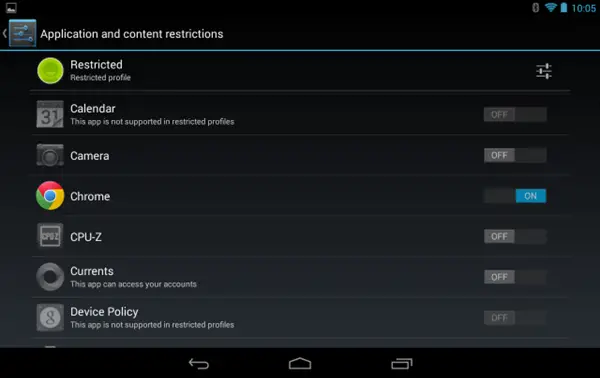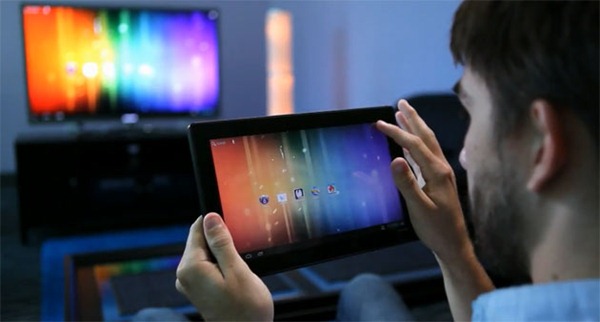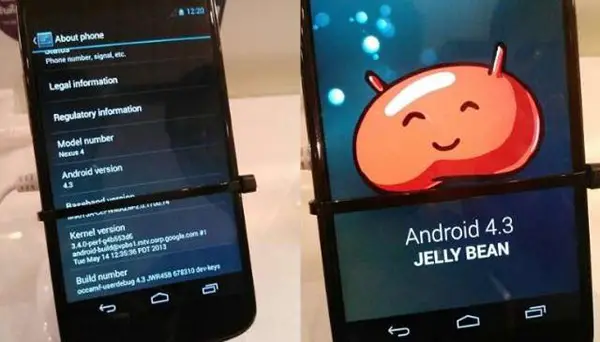The changes brought in the transition from Android 4.2 to 4.3 might not be as significant or as visible as what we noticed in other prominent transitions as 4.0 to 4.1 or others, but some features like Restricted Profiles, Bluetooth 4.0, Wireless display, TRIM, etc. make the upgrade worthwhile. Let us discuss these noteworthy features in more detail.
1. Restricted Profiles
Much like we’re used to seeing on our Windows-based laptops and desktops, the ‘Restricted Profiles’ service lets the owner create profiles for various different users, and granting them access to various services and applications. This comes in handy especially when you have a single device which is used by a group of people. The owner can create a ‘set’ of restricted apps which won’t be accessible to any other user. This feature gives emphasis to the fact that a lot of personal data is being exchanged on phones and tablets today, which exposes the risk of privacy invasion when the device is used by a group of individuals.
By creating this set of restricted apps, the owner can now let anyone else use the device without having to worry about personal data being viewed/stolen by other users. Apps like Gmail and email can only be accessed by the owner and no one else, while most other 3rd party apps can be accessed by other users as well, depending on how the owner configures the profiles. Restricted users also do not have the privilege levels to install their own apps/remove apps.
2. Bluetooth 4.0
The Bluetooth technology is actually a result of software+hardware components. It is incomplete without either not present. The most recent version of Bluetooth is v4.0, which allows for faster data exchange as well as adds support for Smart devices such as jogger shoes or armbands. Most Bluetooth devices we’re used to seeing typically use up a lot of power, and smart devices like those mentioned rectify this and consume much lesser power.
Something noteworthy here is that along with the proper hardware, only the update in software (OS) is needed to be able to use Bluetooth v4.0 devices with your phone. What does this mean? This means that the smartphone you currently own can be used with other smart devices, given that you receive the Android v4.0 update for your phone! This technology, Bluetooth 4.0, is also known as Bluetooth LE (LE for low energy) and was introduced by Nokia way back in 2006!
3. Wireless Display
Most phones today come with MHL or other similar functionalities which let you view your phone’s content on your TV. However, for those who do not like to go through the hassles of completely configuring the phone’s output, connecting the phone and TV via an appropriate cable, adapter for MHL, etc., Android 4.3 has a solution – Miracast.
What is Miracast? Miracast is a protocol which lets users stream their phone’s content to smart TVs and other devices wirelessly! This is to say, you can omit the cables and adapters from your phone to TV display setup. How much easier life seems now!
4. TRIM Support
Most of us have used a handful of devices in our lives, and noticed that, invariably, the devices do get slow and laggy with usage. This problem was recently faced by a large number of Nexus 7 users, which prompted Google to include this update in Android v4.3. Most computers (including phones and tablets) have some internal storage associated with them. This is used to store the OS as well as user files such media, settings, etc. and also, install apps. However, files are stored sequentially and a virtual database keeps record of all these files stored on the disk. This virtual database is also known as metadata (data about data). However, usage of devices includes the deletion of old files and creating of new files, and this happens over and over.
When you delete a file, there is a gap which needs to be filled. For eg, you store files x, y and z on your smartphone, and then decide you do not need y anymore, hence delete it. This creates a void on the physical hard disk (in layman terms, the disk is fragmented), which is logged in the virtual database. What TRIM does is that it tells the system to not log this void in the database, which results in much faster IO operations. This is a very simple solution to an otherwise very complicated problem! Of course, there are many, many more improvements in the latest Android flavour, but covering all would be beyond the scope of this post. Also, not all new features are as ‘visible’ by end-users as those listed here. Let us know if you would like to know about other features, we would be obliged to respond!
Nexus 7 Android 4 3 Update New Features Review[Video]



